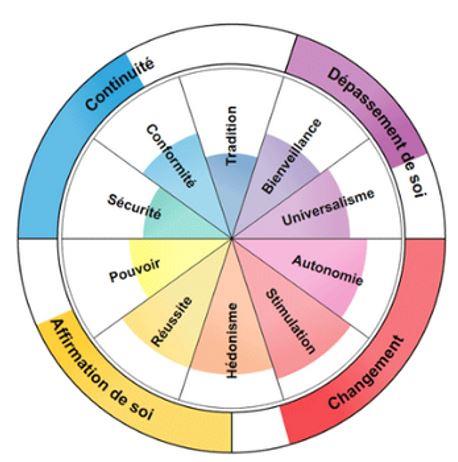
The concept of value
For Schwartz, a value is a belief that refers to an end or desirable behaviour, the expression of motivations intended to achieve particular goals.
And for each individual, values are ordered according to their relative importance as guiding principles of life.
The Schwartz model
•Autonomy. Objective: independence of thought and action - choose, create, explore. (creativity, freedom, choosing one's own goals, curious, independent, self-esteem, intelligent, privacy)
•Stimulation. Objective: enthusiasm, novelty and challenges in life. The stimulation values result from the vital need for variety and stimulation. (a varied life, an exciting, intrepid life)
•Hedonism. Objective: pleasure or personal sensual gratification. The values of hedonism derive from the vital needs of the human being and the pleasure associated with their satisfaction. (fun, loving life, indulging yourself)
•Success. Objective: personal success achieved through the manifestation of socially recognized skills. (ambitious, successful, capable, influential, intelligent, self-esteem, social recognition)
•Power. Objective: prestigious social status, control of resources and domination of people. (authority, wealth, social power, preserving my public image, social recognition)
•Security. Objective: safety, harmony and stability of society, relations between groups and between individuals, and of oneself. (social order, family security, national security, clean, reciprocity of services rendered, healthy, moderate, sense of belonging)
•Conformity. Objective: moderation of actions, tastes, preferences and impulses likely to destabilize or hurt others, or to transgress expectations or social norms. Compliance values arise from the need for individuals to inhibit those of their desires that might interfere with or hinder the proper functioning of interactions and group. (obedient, self-disciplined, politeness, honoring parents and elders, loyal, responsible)
•Tradition. Objective: Respect, commitment and acceptance of the customs and ideas supported by the culture or religion to which we are connected. (respect for tradition, humble, religious, accepting my share in life, moderate, spiritual life)
• Compassion. Objective: the preservation and improvement of the well-being of people with whom we are frequently in contact. The values of benevolence come from the need for the group to function in a harmonious way (helpful, honest, forgiving, responsible, loyal, true friendship, adult love, sense of belonging, meaning in life, spiritual life)
• Universalism. Objective: understanding, esteem, tolerance and protection of the well-being of all and nature. The values of universalism come from the need for survival of individuals and groups. (broad-minded, social justice, equality, a peaceful world, a world of beauty, unity with nature, wisdom, protecting the environment, inner harmony, spiritual life)
The structure of values in addition to identifying ten fundamental values, Schwartz's theory describes the relationships of compatibility and antagonism that these values maintain with each other, in other words the structure of values. This structure stems from the fact that when one acts on a value, it has consequences that conflict with certain values and are compatible with others. This model of values is represented by a circular structure: the closer the values are, the more they share common motivations and are compatible. The more distant they are, the more they may enter into conflict. Two broad dimensions sum up these relations of antagonism and compatibility:
• Open-mindedness (combining autonomy, stimulation and hedonism) is opposed to continuity (bringing together conformity and tradition).
• Transcendence (benevolence and universalism) is opposed to self-assertion (combining power and success).
Shalom Schwartz